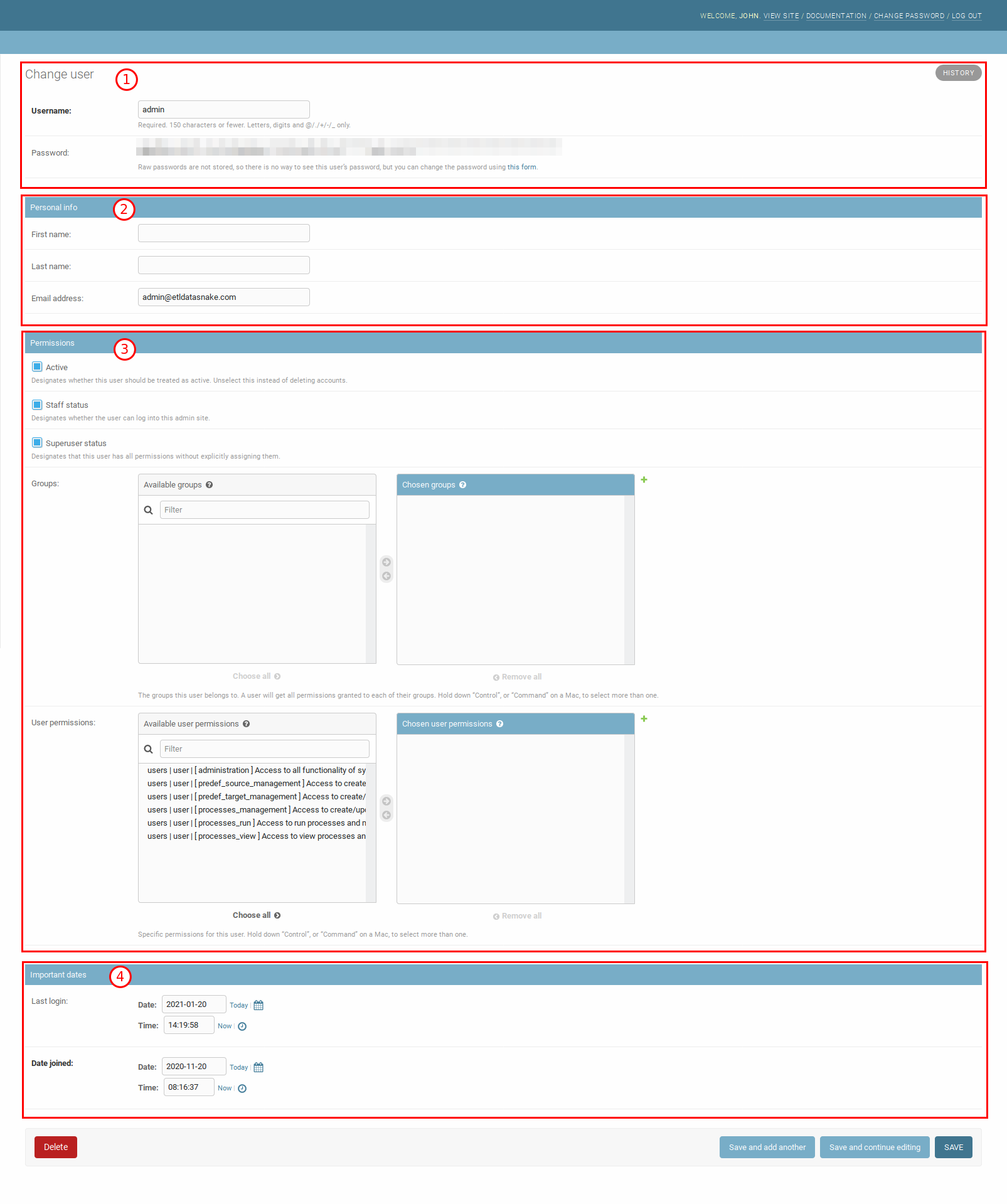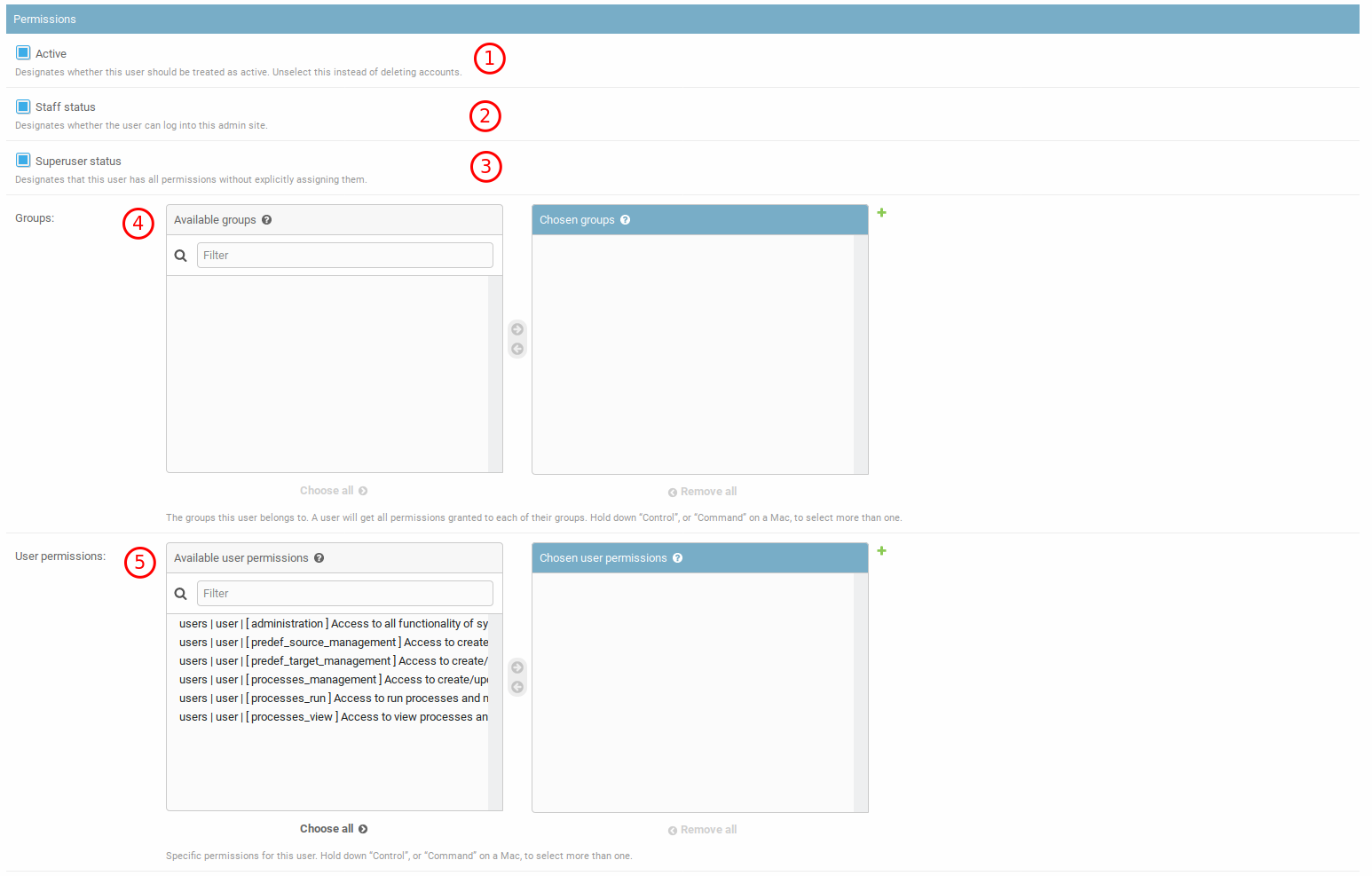Edit a User #
To enter the Edit user section, click the username on the list of Users in the Administration Section. You can also navigate to the Edit User section by clicking the Save and continue editing button while Adding a new user.
When you enter the Edit User section, you can edit the following information:
- Change User - in this section you can change the Username used for login as well as Change the User’s Password,
- Personal Info - in this section you can change details about the User (
First name,Last name,Email address), - Manage Permissions - Here you can change what the User can do while working with ETL data_snake,
- Important dates - here you can check when the User has logged in lately and when the User was created or added.

At the bottom there are four buttons:
- Delete - removes the User permanently; clicking this shows a confirmation dialog; instead of deleting users, it is better to Deactivate them in the Manage Permissions section,
- Save and add another - save changes and navigate to the Add new User section,
- Save and continue editing - save the current changes to the User and stay in this section,
- SAVE - save changes to the User and go back to the Users list.

Changing Password #
To change the selected User’s password, you need to click the this form link located in the Password field.

After clicking the link, you will be navigated to the Change password section where you need to provide only the new password in both fields and click the CHANGE PASSWORD button.

Changing passwords of LDAP Users this way is meaningless, as they are verified using their respective systems!
If you do not want to change the password, simply exit this section without clicking the CHANGE PASSWORD button.
Manage Permissions #
In this part of the Edit User section, you can give the Users access to various parts of
the ETL data_snake software. Every newly created User or a User added by LDAP
does not have any permissions, thus does not have any access to the ETL data_snake software
and is only able to view the Home Page. It is the job of the User with the
Staff status to add permissions to each User.
You can manage permissions by modifying the following fields:
- Active - whether the User can log in to the system; this should be checked unless the User should not have access to the ETL data_snake software; this is the preferred method of removing Users from ETL data_snake as LDAP Users are added automatically upon login, deleting Users is irreversible, and might be impossible, because Users might be connected to other objects in the database,
- Staff status - whether the User can access the Administration Section; this should only be checked if the User is to be permitted to the Administration Section,
- Superuser status - whether the User has access to all parts of the ETL data_snake
software, excluding the Administration Section; when this is checked,
you do not have to give the
administrationpermission to the User, - Groups - manage the groups the User is part of; by default, there are no groups; More information about groups can be found here.
- User permissions - here you can assign specific permissions to the User; select the
permissions you wish to assign from the left table and click on the
rightarrow between the two tables; to remove permissions, select them from the right table and click theleftarrow between the two tables.

Information about what access various User Permissions give is described below in the User Permissions Matrix.
User Permissions Matrix #
| Permission Name | Description |
|---|---|
administration |
[ administration ] Access to all functionality of system |
predef_target_management |
[ predef_target_management ] Access to create/read/update/delete predefined datatarget |
predef_source_management |
[ predef_source_management ] Access to create/read/update/delete predefined datasource |
processes_management |
[ processes_management ] Access to create/update/remove processes and modifiers |
processes_run |
[ processes_run ] Access to run processes and modifiers |
processes_view |
[ processes_view ] Access to view processes and modifiers |
Notice that a User with theprocesses_managementpermission does not need theprocesses_runnorprocesses_viewpermissions and a User withprocesses_rundoes not needprocesses_view, but cannot create/update/remove Processes and Modifiers.
Thepredef_target_managementandpredef_source_managementpermissions need to be granted additionally to a user withprocesses_management,processes_runorprocesses_viewpermissions if the user should have access to managing Predefined Sources or Targets
A User with theadministrationpermission does not have access to the Administration Section. You have to give that User theSuperuser statusorStaff statusdescribed above in the Manage Permissions section.